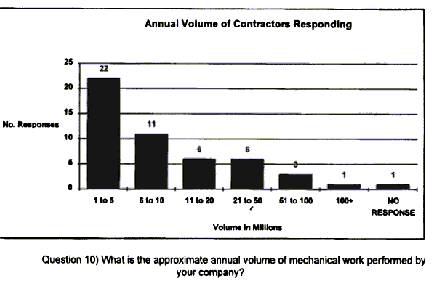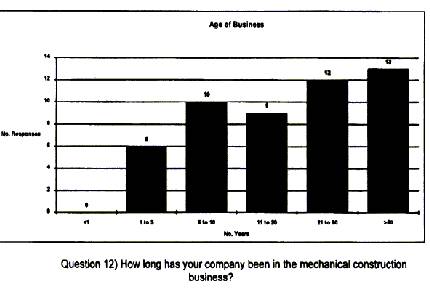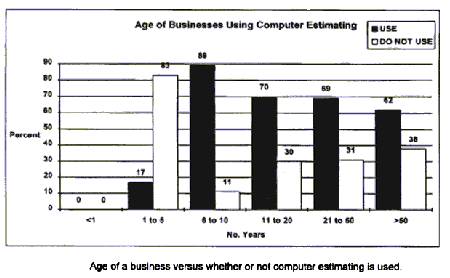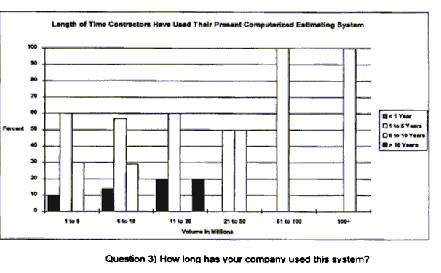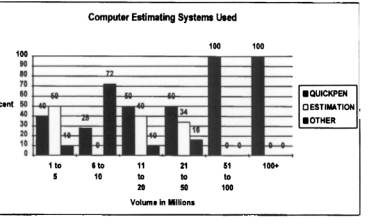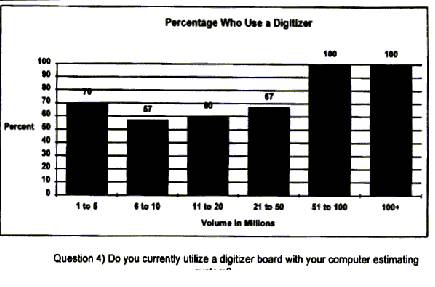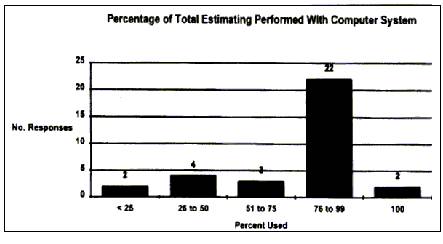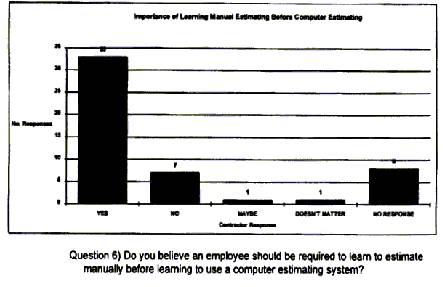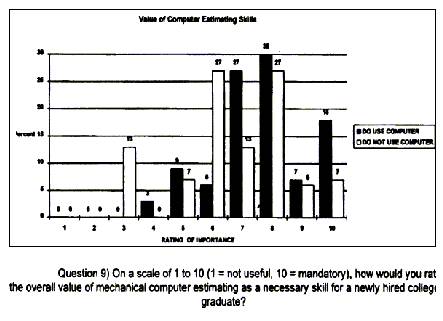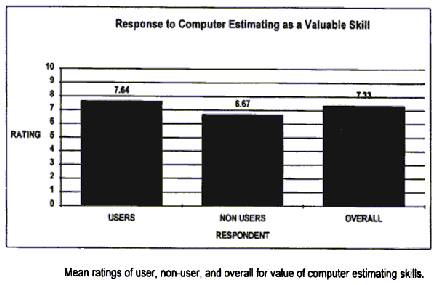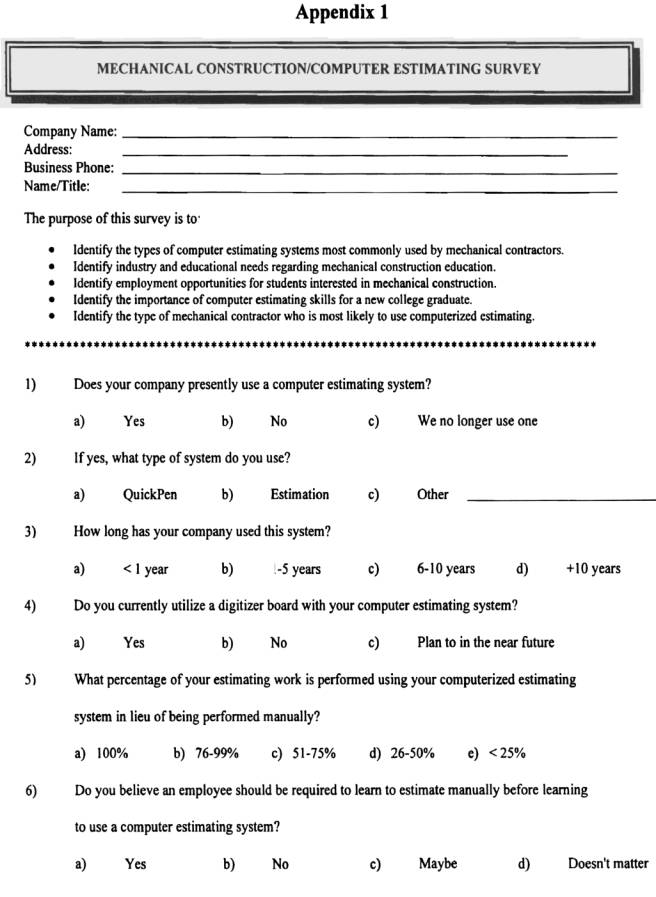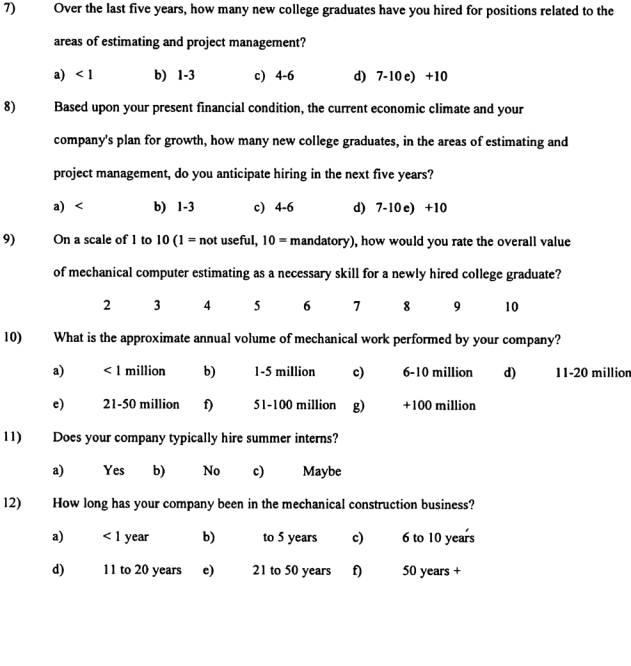|
(pressing HOME will start a new search)
|
|
Teaching
Mechanical Construction Estimating: Information for Course Development
John R. KoontzDepartment
of Building Construction Purdue
University West
Lafayette, Indiana |
James T. RichardDepartment
of Construction Management Florida
International University Miami,
Florida |
|
An increasing number of mechanical contractors are utilizing computerized estimating systems. In parallel, there has been a strengthening request from the mechanical construction industry to provide mechanical construction education at the university level. With the development of a mechanical construction management curriculum comes the question of whether to include computerized estimating, and if so, to what degree. This paper analyzes the data collected from a survey of mechanical contractors and provides information regarding computerized construction estimating for use in the development of a course in mechanical construction estimating. The developmental information received is directed primarily at computerized estimating specific to mechanical construction. This paper identifies the computerized estimation systems being used, the profile of the contractors using them, the degree of usage in the industry, and the mechanical contractors AE opinions regarding the importance of computerized estimating as a necessary skill for newly-hired college graduates. The information presented in this paper is offered to assist educators in determining the content of a potential mechanical option program. Keywords:
Contractor,
Mechanical Construction, Course Development, Computerized Estimating,
Digitizer, Estimating, Survey, Estimation, QuickPen, Teaching. |
Introduction
For
the past two years, the Department of Building Construction and Contracting at
Purdue University has been in the early stages of creating a Mechanical
Construction Management Option program. The Building Construction department,
always an advocate of collecting industry advice and support towards the
establishment of new educational programs, established an ad hoc mechanical
advisory council. Since its inception, several advisory meetings between the
mechanical contractors and the Building Construction Department have been held
to determine industry needs, departmental needs and educational goals, and the
future direction of the program.
Through
these meetings, the advisory council determined that the mechanical option
program should contain a course in mechanical construction estimating. In
addition, the mechanical construction estimating course should include the use
of a computerized estimating system specific to the mechanical construction
industry. Advisory council mechanical contractors were adamant in their belief
that a student should be taught estimating specific to mechanical
construction. They felt strongly that the completion of courses in general
construction estimating alone were not sufficient for the graduate who accepts
employment with a mechanical contractor. As a result, all parties agreed that
mechanical contractor information regarding computer estimating usage should
be collected. Therefore, from November 1993 to February 1994, a survey was
conducted by Purdue's Building Construction department to provide useful
information in developing the course. Fifty Indiana mechanical contractors of
various annual volumes were surveyed to collect information relative to
estimating and to potential graduate placement. For reference, the survey
instrument can be found in Appendix 1. The primary intent of the survey,
relative to mechanical construction estimating, was to identify the following:
-Industry
and educational needs
-Importance
of computer estimating skills for new college graduates
-The
profile of the mechanical contractor using computerized estimating
As
a note, this survey instrument additionally contained several questions
regarding summer internships and graduate placement. This paper does not
address these issues as they are not directly related to the development of an
estimating course in mechanical construction.
The
Study
Presented
here are the results of the study.
What
is the profile of the mechanical contractors who were surveyed?
The
profile of the fifty mechanical contractors surveyed covers the entire
spectrum from very small to very large. The contractors were found to have
annual volumes which ranged from one million to over 100 million dollars. The
majority of the mechanical contractors surveyed are members of the Mechanical
Contractors Association of Indiana (MCAI).
The
survey instrument requested information regarding the annual volume of the
contractor to determine if estimating methods and needs varied between smaller
and larger contractors. Their responses are displayed by contractor annual
volume and number of contractors in Figure 1. Ninety percent of the responding
contractors had volumes of 50 million or less. One contractor, due to privacy
concerns, demurred to provide information regarding annual volume.
|
|
|
Figure
1. |
The
number of larger contractors as related to the number of smaller contractors,
as presented in Figure 1, was discussed with Mr. Roger D. Beesley, the
Executive Vice President of the Mechanical Contractors Association of Indiana.
Mr. Beesley's comment was "these percentages by size appear to be a
typical cross section of the mechanical contractors in the Midwest. There are
many small contractors and a few large contractors, just as one would
expect."
Information
regarding the number of years that the responding contractors have been in
business was collected to determine if contractor age affects or is related to
computer estimating usage. Figure 2 exhibits a range in ages. The range in
ages of responding contractors is approximately 1 year to over 50 years old.
Eighty eight percent of the 50 businesses who responded are 6 years old or
older. Figure 2 indicates a fairly equal distribution of businesses in each
age category.
|
|
|
Figure
2. |
Do
mechanical contractors use computerized estimating?
Computers
today are an accepted tool for mechanical construction companies. In the early
1970's, most contractors initially used mainframe computers for the purposes
of data processing and bookkeeping. During the mid-to-late 1970's, the
construction market and the national economy experienced drastic change.
Operating costs soared and the number of competitors grew. To adapt to these
changes, contractors were forced to become more cognizant of labor and
material costs, and to find methods to track and control them. In the 19801Es,
contractors began to use personal computers for frontline functions such as
project management and estimating to gain more control of their project costs.
This new application of the computer helped contractors to streamline their
businesses and maintain their market share.
To
continue to meet new challenges head-on, many contractors are improving their
efficiency at the onset of a project by utilizing computer estimating systems.
Computer estimating systems not only improve estimating efficiency, they
improve material ordering, field labor scheduling, and trade coordination.
To
incorporate contractors' current utilization of computerized estimating,
information was collected and evaluated from local Indiana mechanical
contractors. Sixty six percent of the responding contractors use some form of
computerized estimating system. Figure 3 represents the responses received
from contractors by various annual volumes regarding their usage of
computerized estimation.
As
indicated in Figure 3, contractors surveyed with a volume of greater than 5
million maintain a much higher percentage of computer estimating usage than
those with a volume of less than 5 million. Only 45 percent of those
contractors surveyed who have an
annual sales volume of less than 5 million maintain usage of some form
of computerized estimating. From this data, it appears that the higher a
contractor's volume, the more likely the contractor is to use computerized
estimating. 100 percent of the contractors surveyed with an annual volume in
excess of 20 million use some form of computerized estimating.
The
contractor age ranges collected and illustrated in Figure 2 were drawn upon to
assist in answering questions such as, "Do younger companies or older
companies tend to use computer estimating?" Figure 4 displays which age
ranges use computer estimating. In Figure 4, the contractors surveyed who most
use (89 percent usage) computer estimating are in the 6 to 10 year old range,
while the contractors in the less than 6 years old range appear to be the
least likely (17 percent usage) to use computer estimating. Stated
differently, 83% of the companies less than 6 years old do not use computer
estimating. A possible assumption regarding the younger companies is that they
are yet to establish themselves financially and may be unable to make the
major capital investment required to acquire a computer estimating system.
|
|
|
Figure
4. |
A
further observation from Figure 4 includes noting that the percentage of
non-users (other than those companies less than 6 years old) increases as the
age of the companies increases. Although computerized estimating systems have
been in use in some form since the late 1960's, not all contractors have
chosen to use them; and many of those who have chosen to use them only started
recently. It would be interesting to learn the reasons for non-usage, however,
the answer is beyond the scope of this survey.
How
long have mechanical contractors been using computer estimating?
In
reviewing the information provided by Figure 5, one can see that although
various forms of computerized estimating systems have existed lb for more than
25 years, the majority (the author &E additional analysis of the data
found 70%) of the users have used their present computerized estimating
systems for less than 6 years. This figure includes those companies who have
replaced their archaic systems with newer, more advanced systems, and those
companies who have acquired their first systems. Based on this statistic, such
newness would seem to warrant educational support by academia to provide
graduates who are able to conduct computerized mechanical estimation.
|
|
|
Figure
5. |
Which
computer estimating systems do mechanical contractors use?
The
number of computer estimating systems available today seems infinite. The
trade journals of the mechanical construction industry are peppered with
advertisements from vendors offering a new, exciting, and cost-effective way
to estimate mechanical construction work. To a new contractor or a contractor
unfamiliar with computerized estimating, this sea of choices must appear
confusing. In addition to the heavily advertised packaged vendor systems, many
contractors over the years have created their own personalized systems. When
surveyed, the responding contractors were asked to name the brand of computer
estimating systems their companies currently use. The results are illustrated
by contractor annual volume in Figure 6.
|
|
|
Figure
6. |
Two
major brands, QuickPen and Estimation, are used by nearly 73 percent of the
contractors surveyed. This fact came as no surprise to the authors as QuickPen
and Estimation are seasoned professional corporations who provide quality
systems and retain major advertising budgets, and who have extended aggressive
sales efforts to members of mechanical trade organizations in the past decade.
Responses from the remaining 27 percent, in the Other category, contained many
personalized systems of non-familiar brands, and an occasional mention of
known brands such as MCI and WinEst. A noticeable pattern is that apparently
the larger the contractor is, the more likely the contractor is to use the
QuickPen system, and the smaller a contractor is, the more likely the
contractor is to use the Estimation system. According to Mr. Stephen Churchill
of Estimation, Inc., "This is likely because in the early-to-mid 1980's,
QuickPen made
a
major sales concentration towards capturing the market of the top 100
contractors in the country. The Estimation marketing effort in past years has
been directed toward the more numerous smaller companies. Our system requires
a much smaller capital investment than QuickPen and therefore has greater
appeal to smaller companies with smaller budgets." Mr. Churchill reports
that "due to major software developments, such as the Estimation system's
compatibility with Microsoft Windows, Estimation has recently made great
strides in capturing a larger share of the big contractor market."
Do
mechanical contractors use digitizers with their computer estimating systems?
Most
of the computer estimating systems used in the late 1970's and early 1980's
required the manual input of all takeoff quantities. After manual data input,
the old systems would collect the appropriate material and labor units from
the data base, calculate automatic by-products, and then extend labor and
material items to produce subtotals and totals. The data input function of the
old systems was slow and tedious for even the quickest estimators. Performing
any type of material substitution analysis or labor unit comparisons prior to
bid time was difficult, time consuming, and often required all data to be
re-entered for each analysis.
To
overcome the tedious takeoff and entering of quantities, rapid electronic
takeoff means were developed. Most of the newer, more advanced computerized
estimating systems of the late 1980's and early 1990's, such as Estimation and
QuickPen, provide for the electronic takeoff of materials by using a digitizer
board and pen. In addition, most of the newer systems allow the estimator to
choose between manual or electronic quantity input. Even the most open-minded,
experienced estimator might not initially trust the digitizer pen for input,
so providing the option to work both ways allows flexibility.
Most
estimators who have experienced both the manual and digitizer methods of
quantity takeoff typically find that the digitizer method is a great saver of
time and aggravation. Mr. Robert Snodderley, Chief Estimator for. the Ed Grace
Company, a 10 million dollar per year, Lafayette, Indiana, mechanical
contractor, states, "I'm 50 years old and have been estimating for 27
years. As with the Xerox and the FAX machines, I can't imagine manually taking
off a large project since we acquired our QuickPen system and digitizer.
Mechanical estimation involves the quantification of many intricate parts and
is time consuming. The digitizer saves me 20%30% of the normal estimating time
involved."
Like
any saver of time, there is the drawback of initial cost. The option of adding
a digitizer to a computer estimating system can cost as much as $1500 to $3000
for hardware alone.
Of
me contractors surveyed who use a computerized estimating system, 70 percent
use a digitizer for quantity takeoff, and 3 percent plan to use a digitizer in
the near future. Figure 7 exhibits by contractor annual volume the percentage
of mechanical contractors who use digitizers with their present computer
estimating system.
|
|
|
Figure
7. |
It
is apparent that most of the contractors surveyed find it beneficial to use a
digitizer with their system. However, it is unknown how many who do not have
digitizers with their systems would use one if it were available.
To
what extent do contractors use their computer estimating systems?
Although
the computer is used for a substantial amount of estimating work by the
contractors surveyed, 25 percent of the estimating work is still completed
manually. The data shows that nearly 73 percent of the contractors who use a
computer estimating system use it to complete 75 percent or more of their
total estimating work. Figure 8 displays a percentage breakdown of the total
responses to Question 5 regarding estimating work utilizing the computer.
|
|
|
Figure
8. |
Should
manual estimating be taught before computer estimating?
With
the majority of the surveyed contractors using computer estimating systems for
the majority of their estimating work, it would appear that emphasis on
computer skills for an estimating employee should be the strongest. However,
the data collected and illustrated in Figure 9 indicates that the importance
of learning manual estimation skills is also felt strongly by those same
contractors.
|
|
|
Figure
9. |
Thirty
three of forty two contractors (79%) who responded to the importance of manual
skills education felt strongly that an employee should be required to learn
manual estimation before learning to estimate with the computer. Only 17
percent felt strongly that it was not necessary for an employee to learn
manual estimating skills first. Five percent did not feel strongly committed
either way, and 8 of 50 contractors did not respond.
Is
it important to teach computer estimating specific to mechanical construction?
How
would you rate the overall value of computer estimating specific to mechanical
construction as a necessary skill for a newly hired college graduate? This
question was asked of the 50 mechanical contractors to determine the
importance of a computer estimating course specific to mechanical construction
in a mechanical construction option curriculum. The contractors were asked to
rate the importance on a scale of 1 to 10, with 1 being not useful, and 10
being mandatory. Figure 10 illustrates the responses to this question of
overall value from both users and non-users of computer estimating.
|
|
|
Figure
10. |
Figure
11 displays the mean of the information from Figure 10.
|
|
|
Figure
11. |
The
responses to the question regarding the overall value of computer estimating
specific to mechanical construction as a necessary skill fog newly hired
college graduates, from both uses and non-user contractors, were surprising. I
the authors had been asked to speculate before receiving the survey results, a
strong Mandatory (computer estimating skills specific to mechanical
construction is important) response from the users of computerized estimating,
an a strong Not Useful (computer estimating skill; specific to mechanical
construction is not important) response from the non-users of computerized
estimating would have been expected. However, a weaker Mandatory response from
users, and a stronger Mandatory response from non-users was received.
Strong
Mandatory responses to the value of computer estimating skills from non-user
contractors, as well as from user contractors, would tend to indicate that the
majority of the contractors surveyed have a high opinion of the importance and
necessity of computer estimating skills for a newly-hired college graduate.
One speculation regarding the strong Mandatory responses from the non-users is
that perhaps the non-users (34% of those surveyed) will someday wish to use
computer estimating, and will seek graduates educated in computer estimating
specific to mechanical construction. Regardless of the non-user reasons for
valuing computer estimating, both the users' and non-users' responses reflect
positively towards the importance and necessity for computerized estimating
specific to mechanical construction within a mechanical construction
curriculum.
Conclusion
From
this study, several valuable pieces of information have been acquired which
will assist in the development of estimating courses in mechanical option
programs. The following significant statements may be generally concluded from
this study:
-
Both non-users and users feel strongly about the importance of graduates who
are knowledgeable about manual estimation as well as computer estimation
-
66% of Indiana mechanical contractors surveyed use some form of
computer estimating
-
73 % of the users surveyed use QuickPen or Estimation 70% of the users
surveyed use a digitizer with their computer estimating system
-
70% of the users surveyed have used their system for less than 6 years
-
83% of the contractors surveyed who are less than 6 years old are not
users
-
55% of the contractors surveyed with an annual volume of less than 6
million are not users
Although
additional study and development are required, the initial direction and
content of estimating courses in mechanical option programs can be determined
by the above conclusions.
The
following statements should be used as guidelines for initial course
development:
Students
should be taught manual estimating prior to computer estimating.
Most
contractors surveyed felt strongly that a graduate learn the fundamentals of
estimating for mechanical construction by first learning manual estimating.
Among the reasons for their belief lies the fact that projects must still be
estimated even if the computer stops working.
Students
should be taught computerized estimating for mechanical construction.
Most
Indiana mechanical contractors surveyed use some form of computerized
estimating, and they felt strongly that a graduate possess computerized
estimating skills for the mechanical construction industry. Therefore,
graduates pursuing work with mechanical contractors should be literate in the
area of computerized estimating specific to mechanical construction.
The
computerized estimating portion of the mechanical option course should be
taught using an industry standard system such as QuickPen or Estimation with a
digitizer board and pen.
Most
contractors surveyed presently use a QuickPen or Estimation system. Therefore,
if financially feasible to the university, the computerized estimating systems
and hardware used in mechanical construction courses should replicate what
industry is using. Graduates possessing computerized estimating skills
specific to mechanical construction will be in increasingly greater demand. It
is evident that
most
of the contractor users surveyed were new users with much to learn about their
systems. It is probable that several smaller and younger mechanical
construction companies who will survive and grow older are likely to acquire
computer estimating systems. Educators must respond to this growth by ensuring
that manual and computerized estimating skills specific to mechanical
construction, with industry's widely-used systems, be provided in the
curriculum.
References
Adcox,
J. W., Jr., (1993). Construction advisory committee by the year
2000.Proceedings of the 29th Annual Conference of the Associated Schools of
Construction. pp. 7-11.
Chick,
D. (1992, July 7). Changing role of the estimator. Cost Engineering. pp.
23-25.
Seltz,
A. (1989, July 6). Mouse driven program redefines estimating. ENR. p. 37.
Matthewson,
C. (1990). The influence of computers on estimating and bidding. Proceedings
of the 26th Annual Conference of the Associated Schools of Construction. pp.
101-106.
Mezick,
D. (1993, October). Pen computing catches on. Byte. pp. 105-106.
Wallace,
G. M., Killingsworth, R., Cooper, T. E., & Love, T. A. (1990). The use of
CADD interactive software in an advanced estimating course. Proceedings of the
26th Annual Conference of the Associated Schools of Construction. pp. 35-40.
Ward,
J. R., & Schultz, D. (1993, January). Digitizer renaissance. Byte. p. 251.
Interview with Stephen K. Churchill, Field Training Representative for
Estimation, Inc., September 23, 1994.
Interview
with Roger D. Beesley, Executive Vice President for the Mechanical Contractors
Association ofIndiana, Inc., September 27, 1994.
Interview
with Robert J. Snodderley, Chief Estimator for Ed Grace Company Mechanical
Contractors and Engineers, October 6, 1994.
|
|
|
|
